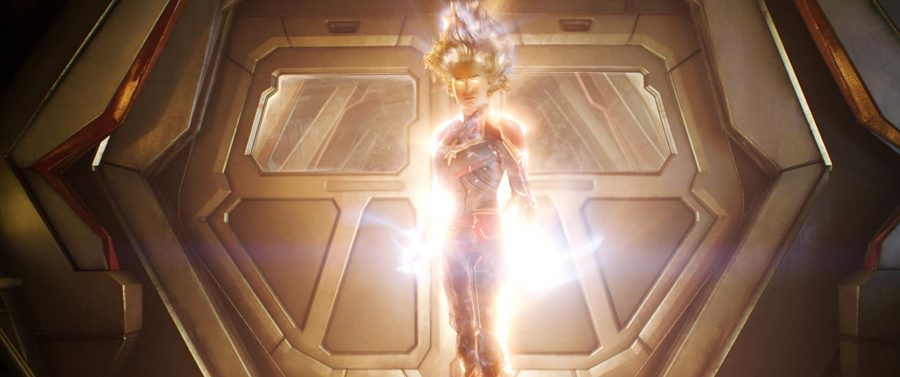Captain Marvel Is Neither the best nor the Worst
March 28, 2019
As the Marvel Cinematic Universe continues deeper into the lore of its comic book origins, it would seem apparent that superhero movie fatigue would set in. It only took the DC Universe three films for viewers to get sick of its characters, but the MCU is miraculously still thriving with every entry it churns out, with many more on the way. The newest flick is Captain Marvel, which marks the first female-led solo superhero movie for Marvel. DC already threw their hat into the ring with the massively successful but hollow and safe Wonder Woman, and after the disappointment of that film, I had my doubts going into Captain Marvel.
Brie Larson (Room, Scott Pilgrim vs. the World) takes on Carol Danvers–a woman with a complicated past who finds herself caught in a war between the shape-shifting Skrulls and the Kree. She must fight the Skrulls, figure out the murky details of her past, and save planet Earth while also gaining the confidence to be the warrior she is destined to be. Along the way, she finds young Nick Fury (a movie-stealing Samuel L. Jackson) and must figure out who to trust, for the Skrulls can shape-shift into anybody she assumes she can trust.
Captain Marvel breaks itself up into three sections: the space-epic the first twenty minutes promise, the buddy-cop action film which the bulk of the film is made up of, and the typical Earth-saving superhero movie of the last thirty minutes. Of these three, the best is easily the second, in which Samuel L. Jackson gives his best Nick Fury performance yet and the best moments of the film are contained. Jackson is the glue that holds the film together, and without him the majority of the humor would have fallen flat. While others gave fun and sometimes emotional performances, I always looked forward to the moments in which Jackson bantered with the other characters. In fact, the quality of the film exponentially increases when he first appears on-screen outside of a Blockbuster Video while investigating a supposedly routine case.
Others give quality performances, such as Jude Law as the protagonist’s former mentor and Ben Mendelsohn as the leader of the Skrulls. However, the standout supporting character is Lashana Lynch as Danvers’ friend from her complicated past, who shocked me with the most emotional and subtly-acted scene in the film. I haven’t seen her in anything thus far, and I hope to catch a glimpse of her in the future–preferably with better writing.
Unfortunately, the weakest link in this film when it comes to acting is Larson herself. I don’t believe she performed badly, especially when I have seen her be so radiant in other films. For the first half of the film, her character is kept at a distance from the audience, which creates confusion when it comes to the feelings they should be exerting towards her. Luckily, the second half clears some of the confusion that the first half establishes, but the feeling of connection with Carol Danvers’ emotions never comes flooding in, and I never felt that I got a glimpse into what she was thinking at a certain moment. The reason supporting characters like Nick Fury steal the show is due to the lack of understanding we have of Danvers’ inner workings. This makes it that much harder to empower her and to send a strong message, even though the writers still succeed in doing so by the end of the movie.
By far the biggest issue I have with Captain Marvel is the pacing. The directors, Anna Boden and Ryan Fleck, never seemed to be able to hold a scene for the correct amount of time so the audience could embrace the full impact. In the first third, when the film introduces Captain Marvel’s life on the Kree planet, the audience isn’t given enough time to fully understand the impact it has on her disposition. Because of this, when certain plot elements are introduced later in the film, it was hard for me to grasp how profoundly these events mattered to her personal life. On the flip side, the third act of the film seems to hold each scene about thirty seconds too long: just enough that the audience gets tired of the point that the writers reiterate. If the time spent on these useless and long scenes had been spent on developing the essential storylines near the beginning, then we’d have gotten a better film that trusts the audience instead of spoon-feeding them the morals and themes. That being said, Captain Marvel is an unabashedly fun movie that will give the majority of viewers what they want. While plot stereotypes are included, character stereotypes are avoided by the writers. Diversity is spread throughout the story; the movie satisfies both those who want to see Captain Marvel as an empowered and unique female character, and those who want an entertaining superhero movie without any overt political opinions included. While Captain Marvel is nowhere near the best the MCU has to offer, it is also far from the worst–this is especially astonishing given that this is the twenty-first film in the ever-continuing saga. Before every Marvel movie, I always think it is finally time for fatigue to start setting in when it comes to superhero movies, and I am wrong nearly every time. While I do wish more time had been spent in editing the film to perfection instead of adhering to the typical chichés, it can’t be denied that Captain Marvel is escapism entertainment at its finest, which is all this movie needed to be while audiences wait for Avengers: Endgame to hit theaters.







